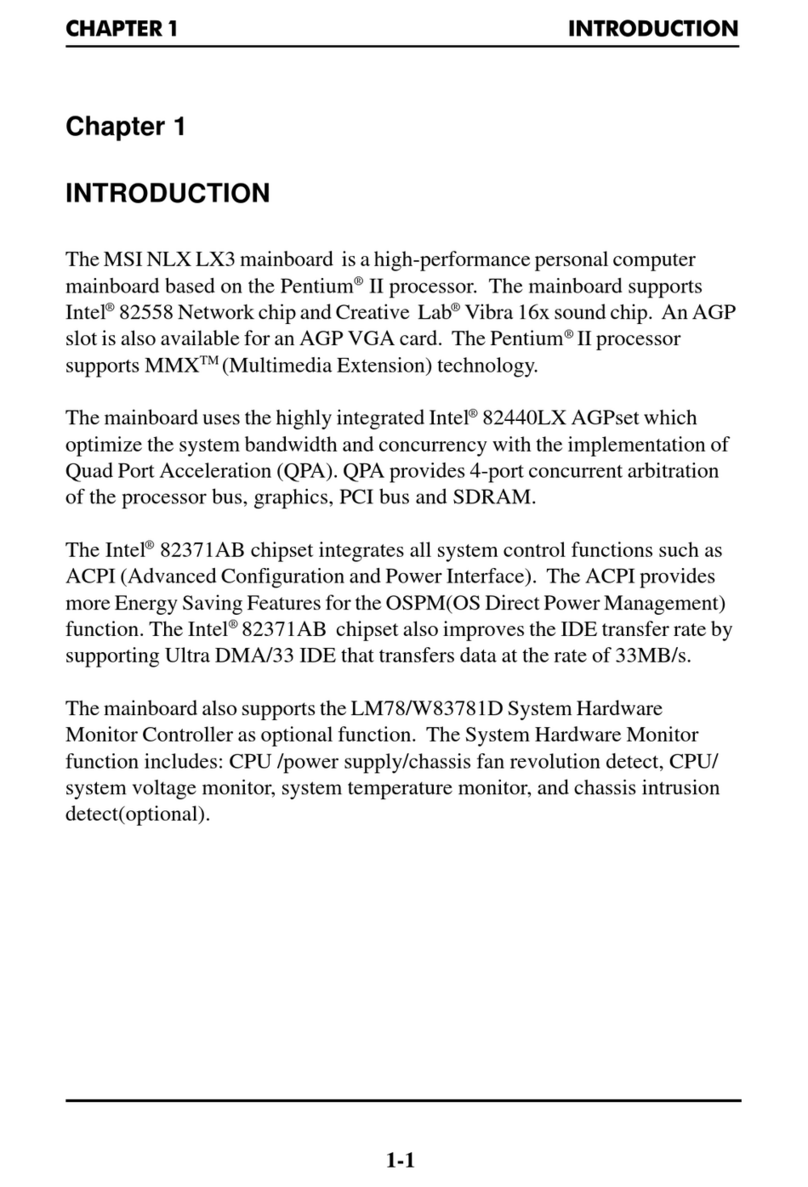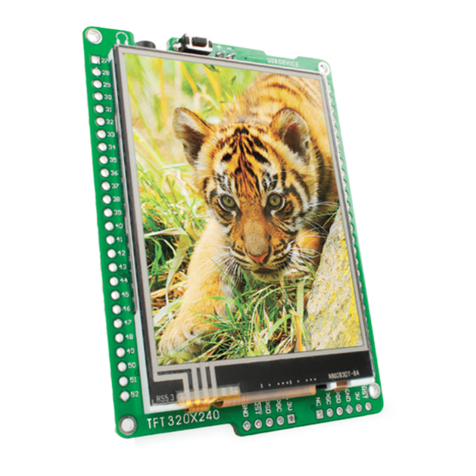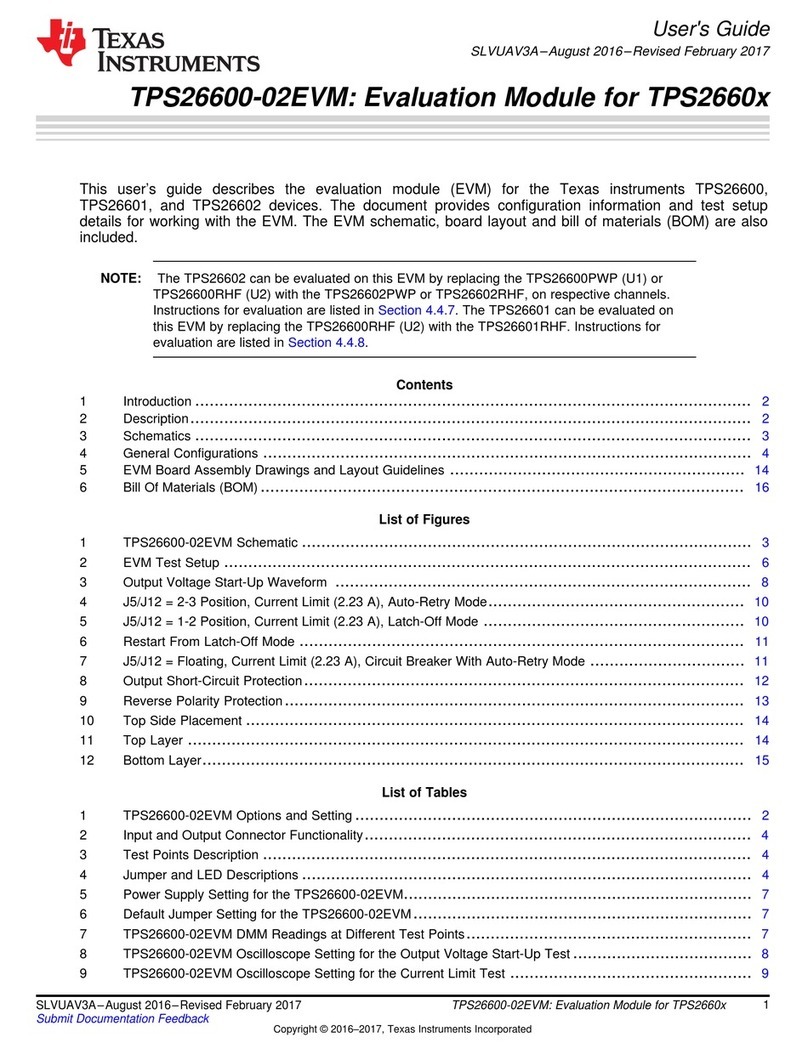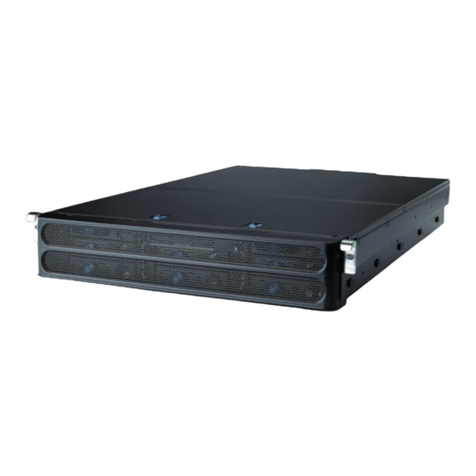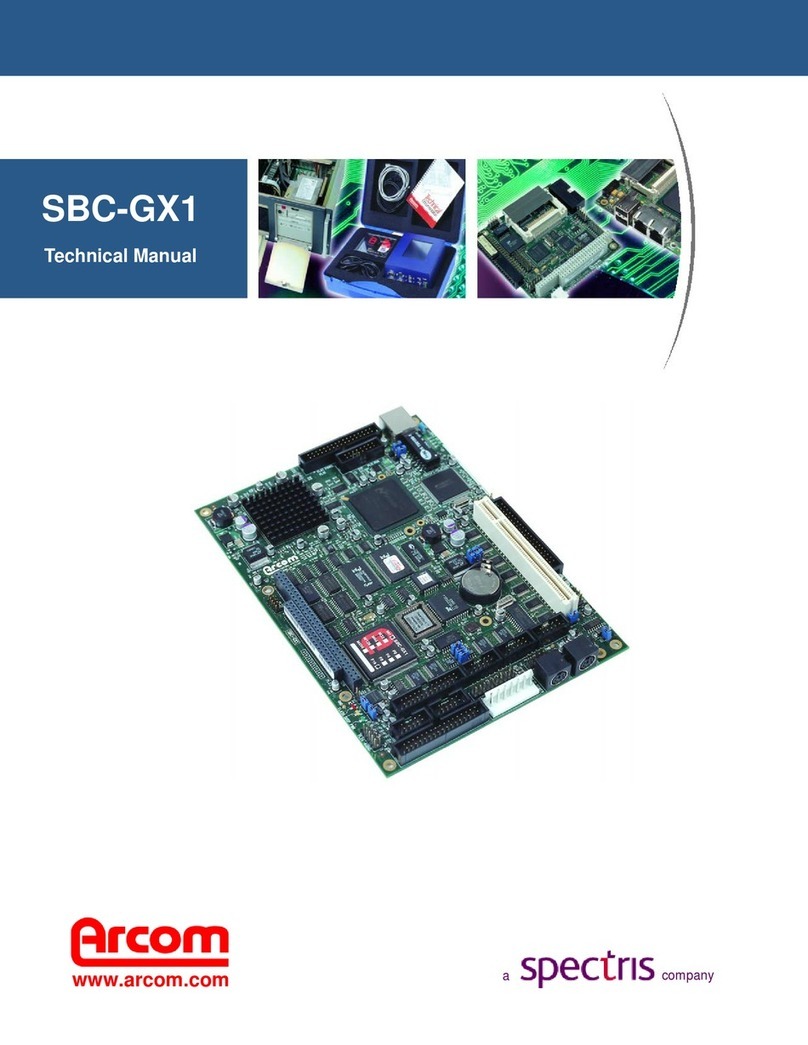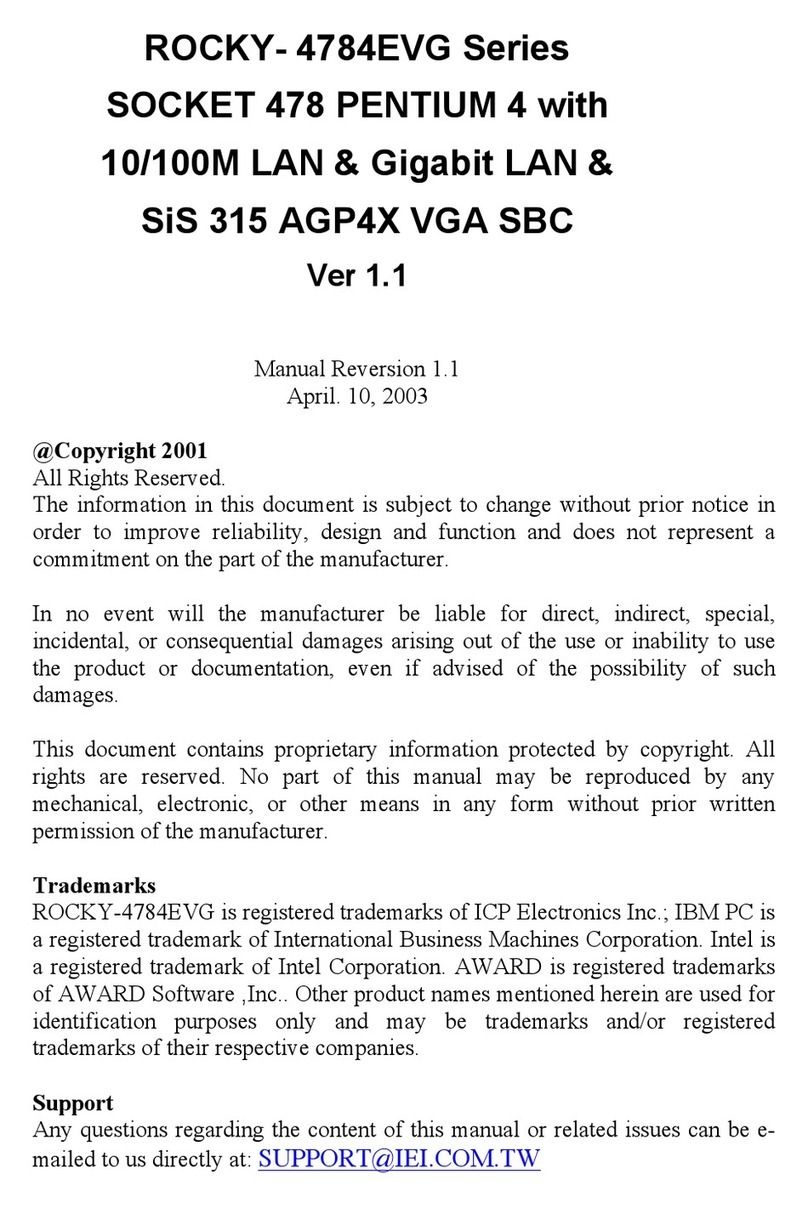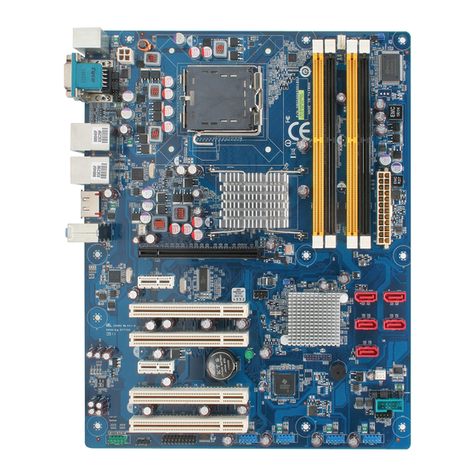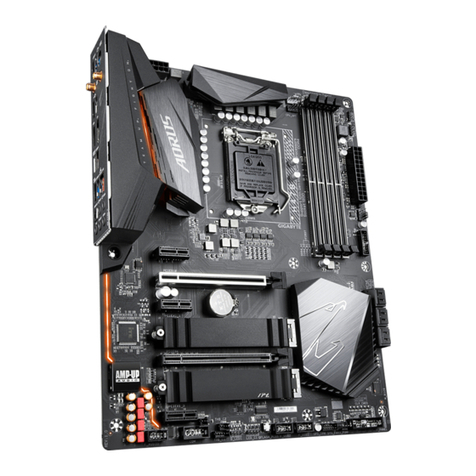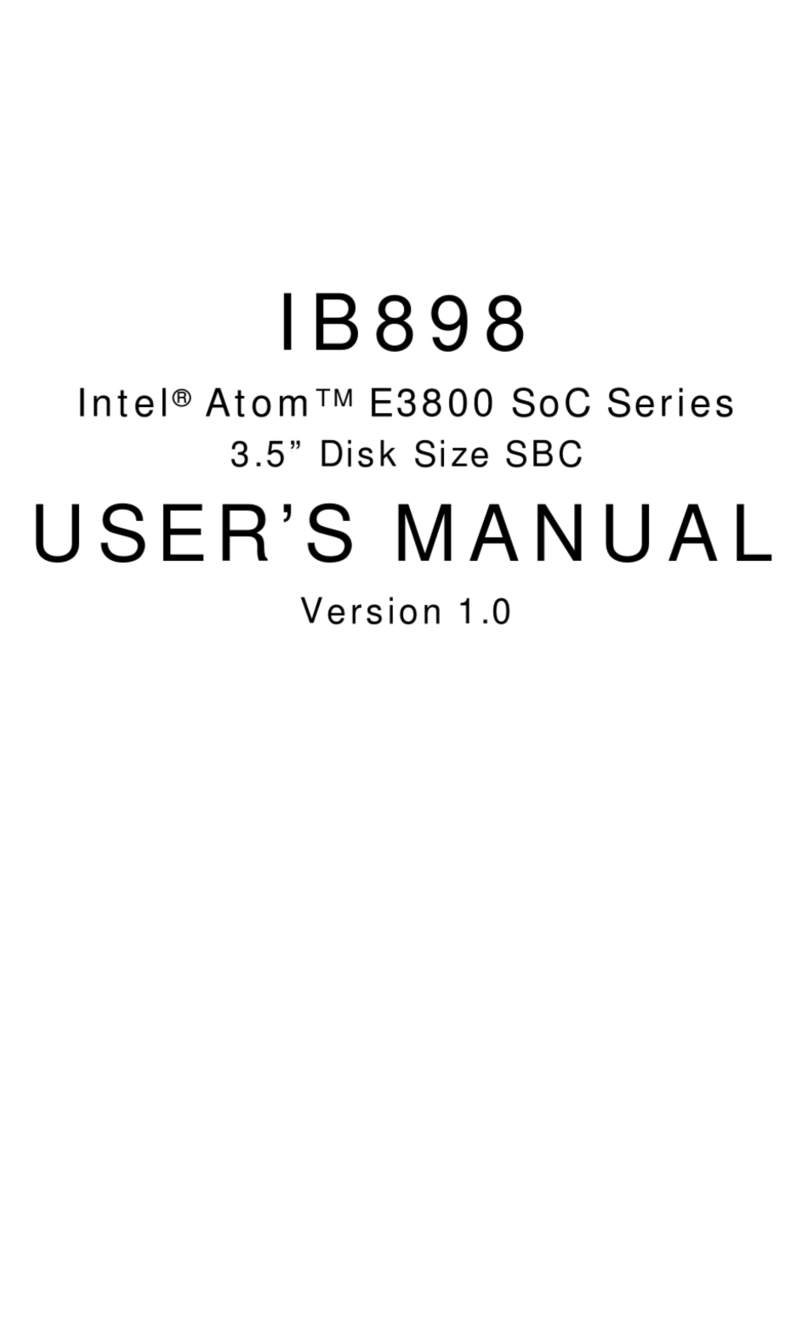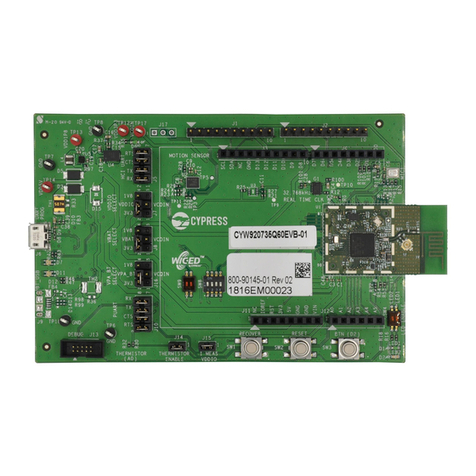MEDIATEK Genio 510 User manual

MediaTek Proprietary and Confidential. © 2022 MediaTek Inc. All rights reserved.
Unauthori ed reproduction or disclosure of this document, in whole or in part, is strictly prohibited.
Use of this document and any information contained therein is subject to the terms and conditions set forth in Exhibit 1. This document
is subject to change without notice.
Version: 1.0
Release date: 2023-10-25
Genio 510 Evaluation Kit
User Guide

MediaTek Proprietary and Confidential. © 2022 MediaTek Inc. All rights reserved. Unauthori ed reproduction or disclosure of this document, in whole or in part, is strictly prohibited.
2
Genio 510 EVK
Genio
510
E
valuation Kit
User Guide
Version History
Version Date Descri tion
1.0 2023-12-25 •First Release

MediaTek Proprietary and Confidential. © 2022 MediaTek Inc. All rights reserved. Unauthori ed reproduction or disclosure of this document, in whole or in part, is strictly prohibited.
3
Genio 510 EVK
Genio
510
E
valuation Kit
User Guide
Table of Contents
Version History ······························································································································································ 2
Table of Contents ··························································································································································· 3
List of Figures ································································································································································· 4
List of Tables ·································································································································································· 5
1
Overview ······························································································································································· 6
1.1
General Information ················································································································································· 6
1.2
Architecture and Block Diagram ······························································································································· 6
1.3
MMD Layout Dimension··········································································································································· 7
1.4
Feature Summary ····················································································································································· 8
2
Introduction ··························································································································································· 9
2.1
CPU (MT8370) ························································································································································ 12
2.2
Power Management IC (MT6365) ·························································································································· 12
2.3
DRAM (Micron MT53E1G32D2FW-046 IT: B) ········································································································· 12
2.4
eMMC Storage (WD SDINBDG4-64G-XI2) ·············································································································· 13
2.5
M.2 Wi-Fi/Bluetooth Module (A ureWave AW-XB468NF) ····················································································· 13
2.6
How to Boot the Genio 510 EVK ···························································································································· 13
2.7
EVK Debug ······························································································································································ 13
3
Interfaces and Connectors ···································································································································· 15
3.1
Genio 510 EVK Board I/O Connectors ···················································································································· 15
3.2
System Power Paths ··············································································································································· 16
3.2.1
Charger Power Source ································································································································ 16
3.2.2
System Power ············································································································································· 17
3.2.3
Raspberry Pi Power 3V3 ····························································································································· 17
3.2.4
Auto Power On by plugin of AC Adaptor ···································································································· 18
3.3
I/O Interface ··························································································································································· 18
3.4
MicroSD Slot ··························································································································································· 22
3.5
Power and Function Key Interface ························································································································· 23
3.6
USB Device ····························································································································································· 23
3.7
USB Host ································································································································································· 23
3.8
Audio Interface ······················································································································································· 23
3.9
Microphones ·························································································································································· 23
3.10
MIPI DSI Interface ··················································································································································· 24
3.11
MIPI CSI Interface ··················································································································································· 24
3.12
Ethernet Interfaces ················································································································································· 24
3.13
HDMI Port How to Switch between DPI and Ethernet Interfaces ·········································································· 24
3.14
Antenna Connector ················································································································································ 24
3.15
How to Switch between DPI and Ethernet Interfaces ···························································································· 25
4
Camera Daughter Board ······································································································································· 26
4.1
D2 Camera Daughter Board ··································································································································· 27
4.1.1 Key Feature and Block Diagram ··············································································································· 27
5
Power Distribution ··············································································································································· 28
5.1
Power Distribution ················································································································································· 28
6
Software ······························································································································································ 29

MediaTek Proprietary and Confidential. © 2022 MediaTek Inc. All rights reserved. Unauthori ed reproduction or disclosure of this document, in whole or in part, is strictly prohibited.
4
Genio 510 EVK
Genio
510
E
valuation Kit
User Guide
6.1
Android ··································································································································································· 29
6.1.1 Android Software Project and Configuration ···························································································· 29
6.1.2 How to get Android Software Image ········································································································ 29
6.1.3 Android Software Image Flash method ···································································································· 29
6.2
Yocto ······································································································································································· 31
6.2.1
Yocto Software Project and Configuration ·································································································· 31
6.2.2
How to Get Yocto Software Image ·············································································································· 31
6.2.3
Yocto Software Image Flash Method ·········································································································· 31
6.3
How to Install Difference Software into Genio 510 EVK ························································································· 32
6.3.1
To Flash IoT Yocto ········································································································································ 32
6.3.2
To Flash Android ·········································································································································· 32
7
A endix ····························································································································································· 33
7.1
Troubleshooting on Camera Application Icon Disappearance ··············································································· 33
Exhibit 1 Terms and Conditions ···································································································································· 34
List of Figures
Figure 1-1. Genio 510 Evaluation Kit System Block Diagram ······································································································ 6
Figure 1-2. MMD Layout Dimension ·········································································································································· 7
Figure 2-1. Genio 510 EVK Board System Setup ························································································································· 9
Figure 2-2. Genio 510 EVK Board I/O Overview ······················································································································· 10
Figure 2-3. Debug Port ····························································································································································· 13
Figure 2-4. UART port setting ··················································································································································· 14
Figure 2-5. Log (For reference) ················································································································································· 14
Figure 3-1. System Power Path ················································································································································· 16
Figure 3-2. Jumper Selection for Charger Power Source Input Path ························································································ 16
Figure 3-3. Jumper Selection for System Power ······················································································································· 17
Figure 3-4. Jumper Selection for Raspberry Pi Power 3V3 Input ····························································································· 17
Figure 3-5. Jumper Selection for Auto Power on by plugin of Adapter ···················································································· 18
Figure 3-6. Configure UART2 Ports ··········································································································································· 19
Figure 3-7. Configure Raspberry Pi Ports ································································································································· 22
Figure 3-8. MT7921 SDIO and MT7663 SDIO Jumper Setting ·································································································· 22
Figure 4-1. D2 installation ························································································································································ 26
Figure 4-2. D2 Camera Board ··················································································································································· 27
Figure 4-3. Block Diagram of D2 Camera Board ······················································································································· 27
Figure 5-1. Power Distribution ················································································································································· 28
Figure 6-1. Flash Tool Window ················································································································································· 30
Figure 6-2. Download Port ······················································································································································· 30
Figure 7-1. Factory reset. ························································································································································· 33

MediaTek Proprietary and Confidential. © 2022 MediaTek Inc. All rights reserved. Unauthori ed reproduction or disclosure of this document, in whole or in part, is strictly prohibited.
5
Genio 510 EVK
Genio
510
E
valuation Kit
User Guide
List of Tables
Table 2-1. Contains in The Box ················································································································································· 11
Table 2-2. Key Component List ················································································································································· 11
Table 2-3. Power Rails ······························································································································································ 11
Table 3-1. Main Board Connectors ··········································································································································· 15
Table 3-2. LED Indicators ·························································································································································· 18
Table 3-3. UART Ports ······························································································································································· 18
Table 3-4. I2C Bus ····································································································································································· 19
Table 3-5. Pin Assignments of the Raspberry Pi like I/O Connector ························································································· 20
Table 3-6. Pin Assignments of the I2S like I/O Connector ········································································································ 22
Table 3-7. USB feature in Genio 510 EVK ································································································································· 23
Table 3-8. Microphone Input ···················································································································································· 23
Table 3-9. SMA Antenna ··························································································································································· 24
Table 3-10. Pin Mux for DPI and Ethernet RGMII Interface ······································································································ 25
Table 4-1. Camera Board Differences ······································································································································· 26
Table 4-2. Collocation of Camera Board and CAM Connector ·································································································· 26
Table 6-1. Android Project name and Configuration ················································································································ 29

MediaTek Proprietary and Confidential. © 2022 MediaTek Inc. All rights reserved. Unauthori ed reproduction or disclosure of this document, in whole or in part, is strictly prohibited.
6
Genio 510 EVK
Genio
510
E
valuation Kit
User Guide
1Overview
1.1 General Information
Genio 510 EVK is an evaluation kit of MediaTek MT8370 platform, integrated with WiFi/Bluetooth (M.2 Module)
which is a high performance IoT platform with rich features.
Note: Genio 510 EVK is only for development and evaluation, please follow the "MT8370 Baseband Design Notice" document
for hardware design rules.
1.2 Architecture and Block Diagram
Figure 1-1. Genio 510 Evaluation Kit System Block Diagram

MediaTek Proprietary and Confidential. © 2022 MediaTek Inc. All rights reserved. Unauthori ed reproduction or disclosure of this document, in whole or in part, is strictly prohibited.
7
Genio 510 EVK
Genio
510
E
valuation Kit
User Guide
1.3 MMD Layout Dimension
•MT8370 + 4-channel DRAM : 30 x 40 = 1200mm²
•PMIC MT6365 : 30 x 20 = 600mm²
•PMIC MT6319 : 7 x 17 = 105mm²
Figure 1-2. MMD ayout Dimension
DRAM
(EMI0 / EMI1)
DRAM
(EMI2 / EMI3)
PMIC MT6319
PMIC MT6365
MT8370

MediaTek Proprietary and Confidential. © 2022 MediaTek Inc. All rights reserved. Unauthori ed reproduction or disclosure of this document, in whole or in part, is strictly prohibited.
8
Genio 510 EVK
Genio
510
E
valuation Kit
User Guide
1.4 Feature Summary
•MediaTek CPU (MT8370)
•MediaTek PMIC (MT6365)
•4GB LPDDR4X RAM (Micron MT53E1G32D2FW-046 IT: B)
•64GB eMMC5.1 x 1 (WD SDINBDG4-64G-XI2)
•2.0mm DC Jack x 1 (for 12V DC Input)
•Micro SD Card Slot x 1
•Push Button x 4 (Power, Reset, Download and Home Key)
•LED x 4 (Power, Reset, System on and Charging Status)
•4-Lane DSI x 2
•eDP x 1
•HDMI2.0 x 1
•10/100/1000M Ethernet x 1 (Shared with DPI Signal)
•USB Device Port x 1 (Micro USB Connector)
•USB Host Port x 1 (Type-C USB Connector)
•3.5mm Earphone Jack x 1 (with Microphone Input)
•3.5mm Line Out Audio Jack x 1
•Analog Microphone x 1
•Digital Microphone x 2
•UART Port x 3 for Trace Log with USB to UART Bridge IC (Micro USB Connector x 3)
•I2C Capacitive Touch Pad
•4-Data Lane CSI x 2
•M.2 Slot x 2 (for A ureWave AW-XB468NF WiFi Module、AW-CB451NF WiFi Module、AW-XB554NF WiFi Module)
•40-Pin 2.54mm Pin Header x 1 (for Raspberry Pi like I/O Interface)
•I2S Pin header

MediaTek Proprietary and Confidential. © 2022 MediaTek Inc. All rights reserved. Unauthori ed reproduction or disclosure of this document, in whole or in part, is strictly prohibited.
9
Genio 510 EVK
Genio
510
E
valuation Kit
User Guide
2Introduction
Genio 510 EVK board integrates MediaTek MT8370 processor, 64bit LPDDR4X memory, eMMC, Power Management IC
(MT6365) , WiFi/BT M.2 Module.
The package contains a Genio 510 EVK Main board, 7” LCD panel, and a stand set for 7” LCD panel.
Figure 2-1. Genio 510 EVK Board System Setup

MediaTek Proprietary and Confidential. © 2022 MediaTek Inc. All rights reserved. Unauthori ed reproduction or disclosure of this document, in whole or in part, is strictly prohibited.
10
Genio 510 EVK
Genio
510
E
valuation Kit
User Guide
Figure 2-2. Genio 510 EVK Board I/O Overview
Camera CSI1
Connector
Camera CSI0
Connector
Ras berry Pi
Connector
Ear hone
Connector
S eaker
Connector
DC
Jack
Battery
Connector
USB(Charger)
Connector
UART2 Debug
Connector
UART1 Debug
Connector
UART0 Debug
Connector
eDP LCM
Connector
HDMI Monitor
Connector
USB-C (DP)
Connector
Micro USB
Connector
RJ-45
Connector
PWR/RST/Home/
Download Key
JTAG Connector
MT7921 Module
- M.2 Connector
RF ANT3
Connector
RF ANT1
Connector
RF ANT2
Connector
Micro
SD
Connector
Micro SIM
Connector
Nano SIM
Connector
LCM0
Connector
CTP0
Connector
CTP1
Connector
LCM1
Connector
I2S
Connector
Ras berry Pi & CPU
Switch Connector

MediaTek Proprietary and Confidential. © 2022 MediaTek Inc. All rights reserved. Unauthori ed reproduction or disclosure of this document, in whole or in part, is strictly prohibited.
11
Genio 510 EVK
Genio
510
E
valuation Kit
User Guide
Table 2-1. Contains in The Box
Table 2-2. Key Component ist
Function
Mfr.
PN
Baseband Processor MediaTek MT8370
Power
MediaTek
MT6365IBW/B
+
MT6319LP/A
+
Discrete Buck/LDO
Charger (Master)
Richtek
RT9471DGQW
Charger (Slave)
Richtek
RT9759WSC
Memory
Micron
MT53E1G32D2FW
-
046 IT: B
eMMC
WD(SANDISK)
SDINBDG4
-
64G
-
XI2
Connectivity
A ureWare
AW
-
XB468NF (MT7921L Module)
LCM
SHENZHEN STARTEK
KD070FHFID078
-
01
-
C021A
V1.3 (7” LCD Panel)
Camera Module (D2) 御光視覺 WDN01A-100 with IMX214 image sensor
USB3.0 HUB IC
Texas Instruments
TUSB8020BIPHPR
B
uck for
Type
-
C PD
Controller
R
ichtek
RT1715WSC
Type C USB Mux IC
ITE
IT5205FN/BX
Ethernet PHY Realtek RTL8211FI-CG
C
rystal
S
IWARD
XTL581150
-
M118
-
181
Table 2-3. Power Rails
Function
Regulator
Default Voltage (V)
ISP
MT6365IBW/B
0.75
GPU
0.75
CPU_L
0.75
CORE
0.75
APU
0.75
C
PU_B
MT6319LP/A
0.75
LPDDR4x VDD2
1
.125
LPDDR4x VDDQ
0
.6
Buck for S
ystem
RT6276AHGQUF
4
.2
B
uck for DRAM
M
A
5721FP/A
0.75
B
uck for WIFI Module
RT5753AHGQWA
3
.3
B
uck for eDP
RT5753AHGQWA
3
.3
B
uck for Camera
RT5753AHGQWA
3
.3
B
uck for
Raspberry Pi
RT9078N
-
08GJ5
3
.3
Boost for USB
p
ower
RT4812GJ8F
5
L
DO for DRAM
M
A6680P/A
1
.8
No
Part Number or Marking
Item Name
Descri tion
Quantity
1 IoT-Genio 510 EVK-P1V2 Genio 510 EVK Main Board 1
2 IoT-CAM-DTB-D1V2-D2 D2 Camera Board Camera Daughter Board Using
IMX214 Image Sensor 1
3 KD070FHFID078-01-C021A 7” LCD Panel LCM Module 1
4
M.2 WIFI6 Module
AW-XB468NF (IC: MT7921L) WIFI Module Installed 1
5 IPEX to IPEX cable Installed 1
6
IPEX to IPEX cable
Installed
1
7
S
MA antenna
WIFI Antenna
Installed
2
8 12V
⎓
4.16A AC adaptor + power cord 1

MediaTek Proprietary and Confidential. © 2022 MediaTek Inc. All rights reserved. Unauthori ed reproduction or disclosure of this document, in whole or in part, is strictly prohibited.
12
Genio 510 EVK
Genio
510
E
valuation Kit
User Guide
2.1 CPU (MT8370)
MediaTek MT8370 processor integrates dual-core ARM® Cortex-A78, 2.0GH processor and six-core ARM® Cortex-A55
2.0GH MPCore processor equipped with the NEON engine offers processing power necessary to support the latest OpenOs
along with its demanding applications such as web browsing, email, GPS navigation, and games.
The features of the MT8370 processor include the following:
•Hexa -Core
•2 x ARM® Cortex-A78 Operating at 2.0GH with each core 64KB L1 I-Cache, 64KB L1 D-Cache and 256KB L2 Cache
•4 x ARM® Cortex-A55 Operating at 2.0GH with each core 32KB L1 I-Cache, 32KB L1 D-Cache and 128KB Cache
•Shared 2MB L3 Cache
•NEON Processing Engine
•ARM TrustZone Security
•DVFS Technology with Adaptive Operating Voltage from 0.55V to 0.973V
•Tensilica VP6 processor with AI Accelerator (AIA or MDLA– MediaTek Deep Learning Accelerator)
•VFGBA-1204 Package
2.2 Power Management IC (MT6365)
MediaTek MT6365 power management IC is a programmable power management IC that integrates 9 buck converters and
33 LDOs to provide all power rails required by SoC and peripherals.
MT6365 adopts the SPI interface and two SRCLKEN control pins to control buck converters, LDOs, and various drivers; it
provides enhanced safety control and protocol for handshaking with the processor MT8370.
For system management, it provides the following features,
•9 Buck Converters
•33 LDOs
•Precision voltage, temperature, and current measurement fuel gauge
•26MH External Crystal for System Clock
•32.768KH RTC Oscillator for System Timing
•Watchdog Reset
•Over-current and Thermal Overload Protection
•OVP, UVLO Function
•WFBGA-203 Package
2.3 DRAM (Micron MT53E1G32D2FW-046 IT: B)
Genio 510 EVK has one 4GB LPDDR4X memory with the following features.
•Dual Channels with 16-bit Data Bus Width
•Supports self-refresh/ partial self-refresh mode
•Supports dual-rank memory device

MediaTek Proprietary and Confidential. © 2022 MediaTek Inc. All rights reserved. Unauthori ed reproduction or disclosure of this document, in whole or in part, is strictly prohibited.
13
Genio 510 EVK
Genio
510
E
valuation Kit
User Guide
2.4 eMMC Storage (WD SDINBDG4-64G-XI2)
A 64GB eMMC 5.1 WD SDINBDG4-64G-XI2 is used for code and data storage, via MSDC0 interface of the baseband
processor MT8370 with 8-bit width data bus.
2.5 M.2 Wi-Fi/Bluetooth Module (AzureWave AW-XB468NF)
MediaTek MT7921L is in A ureWave AW-XB468NF M.2 Module. It supports following features.
•M.2 2230 WiFi Module with Key A-E
•MediaTek MT7921L WiFi Chip
•PCIe/USB Interface
•WiFi 802.11 a/b/g/n/ac/ax
•Dual Band 2T/2R MIMO
•Bluetooth 5.2
•Security WFA WPA/WPA2/WPA3 Personal, WPS 2.0, WAPI
•Integrated LNA, PA and T/R Switch
2.6 How to Boot the Genio 510 EVK
Power on Genio 510 EVK board by following steps.
Step 1: Must install camera board on Genio 510 EVK.
(If camera app disappears in the desktop of Android OS, please refer to chapter 7 Appendix to know the way to fix it. ).
Step 2: Connect UART0 (CN3200) to the computer via an USB cable. (If you want to see the logs).
Step 3: Plug in the DC 12V power adapter.
Step 4: Long Press PWR button more than 3 seconds
You will see the boot-up picture on LCD display and some trace logs come out from UART0.
2.7 EVK Debug
•Micro USB (CN3200)output UART log
•Please install FT232RL driver
•
Figure 2-3. Debug Port

MediaTek Proprietary and Confidential. © 2022 MediaTek Inc. All rights reserved. Unauthori ed reproduction or disclosure of this document, in whole or in part, is strictly prohibited.
14
Genio 510 EVK
Genio
510
E
valuation Kit
User Guide
•Check PC USB port could recogni e the UART device
•Setting serial line (ex. COM57 ) , serial speed to 921600, choose connection type to serial and press OPEN on putty for
Log (Example on Putty)
Figure 2-4. UART port setting
Figure 2-5. og (For reference)

MediaTek Proprietary and Confidential. © 2022 MediaTek Inc. All rights reserved. Unauthori ed reproduction or disclosure of this document, in whole or in part, is strictly prohibited.
15
Genio 510 EVK
Genio
510
E
valuation Kit
User Guide
3Interfaces and Connectors
3.1 Genio 510 EVK Board I/O Connectors
Table 3-1. Main Board Connectors
Interface Location Note
DC Jack CN1000 12V DC Input
System Power Indicator D1002 Green LED
Reset Indicator D3200 Green LED
System On Indicator D1003 Red LED
Charging Status Indicator D1001 Green LED
Power On Button SW3200
Download Button SW3201
Home Key Button SW3202
Reset Button SW3203
USB Device CON480 USB2.0 Port
USB3.1/DP MUX CON490 USB3.1 Port/DP Display Port(MUX)
UART0 CN3200 Debug Port
UART1 CN3201 Debug Port
UART2 CN3202 Debug Port
Micro SD Card Slot CON420
DSI J2300 7” LCM0
DSI J2400 7” LCM1
Touch CN2300 7” Touch0
Touch CN2400 7” Touch1
eDP J3700 15.6” LCM
CSI0 CN2900 Camera 0 Interface
CSI1 CN2901 Camera 1 Interface
HDMI J2500 HDMI Type-A Connector
Ethernet J3900 10/100/1000M Ethernet Transceiver
M.2 Slot Key E J4000 AW-XB468NF(MT7921L) WiFi Module
Raspberry Pi like I/O J4200
JTAG J3200
Earphone Jack J2601
Line Out J2600
Battery Connector J1002
Analog Microphone MIC2702
Digital Microphone 0 MIC2700
Digital Microphone 1 MIC2701

MediaTek Proprietary and Confidential. © 2022 MediaTek Inc. All rights reserved. Unauthori ed reproduction or disclosure of this document, in whole or in part, is strictly prohibited.
16
Genio 510 EVK
Genio
510
E
valuation Kit
User Guide
3.2 System Power Paths
There are two power supply paths for the system. One is through a buck converter (Richtek RT6276A), which convert 12V
(DC Jack) to 4.2V (VSYS). This path supports those applications without Li-Polymer batteries.
The other is through a battery charger IC (Richtek RT9471D). This path supports those applications with Li-Polymer
batteries.
Figure 3-1. System Power Path
3.2.1 Charger Power Source
The user can choose USB type C or DC12V to power the charger ICs by J1003. Usually, any one of them can meet the
requirement for most cases.
Current Rating
Charger Power Source
3 Ampere
Figure 3-2. Jumper Selection for Charger Power Source Input Path
J1000, J1001
ME_SIP-3P
112
2
33
CN1000
Buck
RT6276A
+
-
V
BT1
BATTERY
12
12V+/-5% J1003
USB
Type C
ME_SIP-3P
112
2
33
Cha ge
RT9471D
IDJ-D47B2
IDJ-D47B2 1
3
2
4
5
6
VSYS

MediaTek Proprietary and Confidential. © 2022 MediaTek Inc. All rights reserved. Unauthori ed reproduction or disclosure of this document, in whole or in part, is strictly prohibited.
17
Genio 510 EVK
Genio
510
E
valuation Kit
User Guide
3.2.2 System Power
There are two power paths can be selected by J1000 and J1001 (at the same time) for system power VSYS.
Current Rating
System Power
6 Ampere
6 Ampere
Figure 3-3. Jumper Selection for System Power
3.2.3 Ras berry Pi Power 3V3
Before using the Raspberry Pi like connector, the J4201 need to plug a Jumper to get power.
Current Rating
R
as berry Pi Power 3V3
0.3 Ampere
Figure 3-4. Jumper Selection for Raspberry Pi Power 3V3 Input

MediaTek Proprietary and Confidential. © 2022 MediaTek Inc. All rights reserved. Unauthori ed reproduction or disclosure of this document, in whole or in part, is strictly prohibited.
18
Genio 510 EVK
Genio
510
E
valuation Kit
User Guide
3.2.4 Auto Power On by lugin of AC Ada tor
Before using Auto Power On function by plugin of AC adaptor, the J3001 need to plug a Jumper.
Current Rating
Auto Power On
by lugin of AC Ada tor
0.1 Ampere
Figure 3-5. Jumper Selection for Auto Power on by plugin of Adapter
3.3 I/O Interface
LED Indicators
There are four LED indicators.
Table 3-2. ED Indicators
LED Indicators
Location
Color
Note
System Power Indicator
D1002
Green
LED is on when system power in.
Reset Indicator
D3200
Green
LED is on when reset key is pressed.
System On
Indicator
D1003
Green
LED is on when system is on.
Charging Status Indicator
D1001
Red
LED is on while charging.
UART
There are three UART (UART0 、UART1 and UART2) consoles with USB to UART Bridge ICs (FT232RL) on Genio 510 EVK
board. Users can use these consoles for debug purpose. The connectors are Micro USB type.
•Supports word Lengths from 5 to 8 bits with an optional parity bit and 1 or 2 stop bits
•Supports baud rates from 110 bps up to 961,200 bps
•FTDI USB to UART Bridge FT232RL
Table 3-3. UART Ports
UART Port I/O Connector Pur ose
UART0 CN3200 (Micro USB) Debug
UART1 CN3201 (Micro USB) Debug
UART2 CN3202 (Micro USB) Debug

MediaTek Proprietary and Confidential. © 2022 MediaTek Inc. All rights reserved. Unauthori ed reproduction or disclosure of this document, in whole or in part, is strictly prohibited.
19
Genio 510 EVK
Genio
510
E
valuation Kit
User Guide
Configure UART2 Port
Two Jumper (J4202 and J4203) to select UART2 connect to Micro USB2(CN3202) or Raspberry Pi Conn. (J4200).
Schematic Descri tion
(1) Jumper @ 1-2, UART2 = USB
(2) Jumper @ 2-3, UART2 = Raspberry Pi
Figure 3-6. Configure UART2 Ports
I2C
•Seven I2C buses (I2C0 to I2C6)
•Supports Master Mode Only
•Adjustable clock speed for LS/FS/FS+ mode operation
•Supports 7-bit address
Table 3-4. I2C Bus
I2C Bus Pur ose Note
I2C0
Capacitive Touch Controller
Goodix GS9271
Raspberry Pi I/O
I2C1
Battery Charger RT9471D
Battery
Charger
RT9759
Buck Convertor
MA5721
USB Type C MUX IT5205FN/BX
I2C2
Audio DTB Connector
Raspberry Pi I/O
I2C3 Capacitive Touch Controller Goodix GS9271
Camera Module CSI1
I2C4 USB PD Controller RT1715
I2C5 Camera Module CSI0
I2C6 Camera Module CSI0
SPI
•Support Master/Slave mode
•One chip select output
PWM
•PWM supports old mode and FIFO mode
•The frequency can be set from 0H to 39MH

MediaTek Proprietary and Confidential. © 2022 MediaTek Inc. All rights reserved. Unauthori ed reproduction or disclosure of this document, in whole or in part, is strictly prohibited.
20
Genio 510 EVK
Genio
510
E
valuation Kit
User Guide
Ras berry Pi like I/O Interface
The pin definitions are as followings:
Table 3-5. Pin Assignments of the Raspberry Pi like I/O Connector
Pin # Descri tion Note Pin # Descri tion
Note
1 3.3V 2 5V
3 SDA2 GPIO60 4 5V
5 SCL2 GPIO59 6 GND
7 IO39 8 TXD2 GPIO35
9 GND 10 RXD2 GPIO36
11 IO0 12 PCM_CLK GPIO121
13 IO37 14 GND
15 IO41 16 IO111
17 3V3 18 IO40
19 SPI_MO GPIO81 20 GND
21 SPI_MI GPIO82 22 IO38
23 SPI_CLK GPIO80 24 SPI_CS GPIO79
25 GND 26 IO90
27 SDA0 GPIO56 28 SCL0 GPIO55
29 IO1 30 GND
31 IO26 32 PWM0 GPIO29
33 CMMCLK2 GPIO30 34 GND
35 PCM_SYNC GPIO122 36 IO76
37 IO28 38 PCM_DI GPIO124
39 GND 40 PCM_DO GPIO123
Note:
•VDD_5V power can provide 5V/2A maximum but share with Camera 、HDMI 5V output
•EXT_3V3 power can deliver 3.3V/300mA but share with Audio DTB 、DP MUX and HDMI CEC
•Black words are ground pins
•Red words are power pins
•Green words are special function pins
•Blue words are GPIOs
•Pink words are pins, which multiplex with other function
•
Table of contents
Other MEDIATEK Motherboard manuals
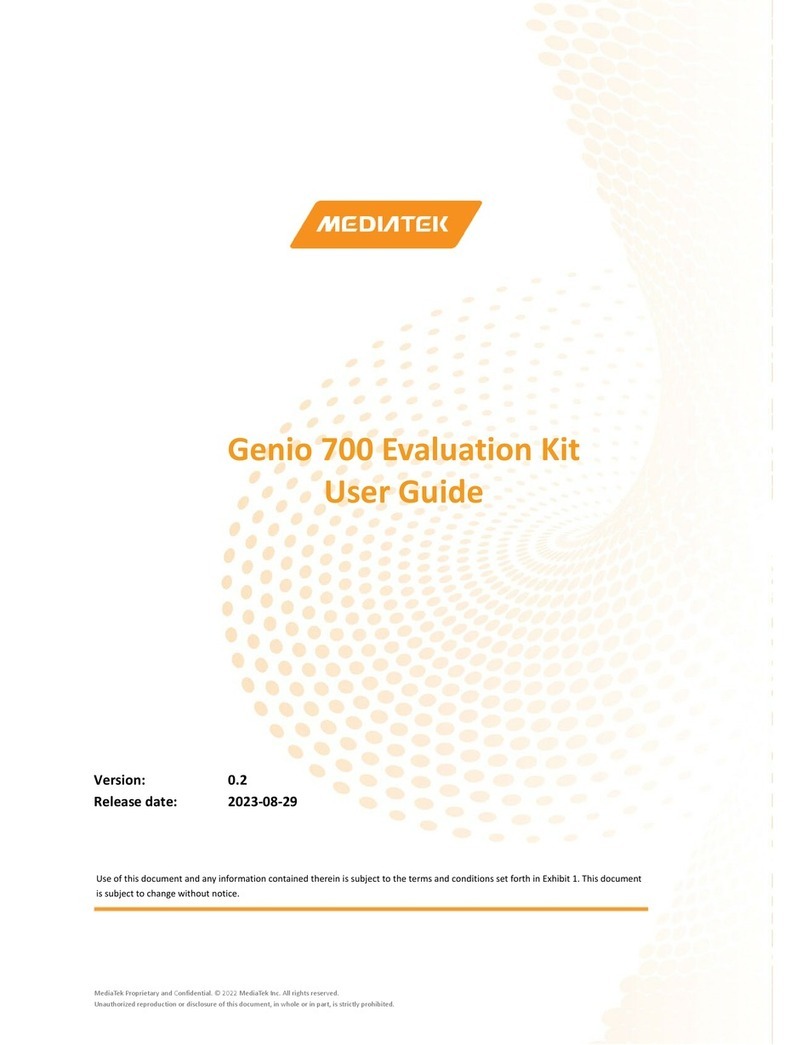
MEDIATEK
MEDIATEK Genio 700 EVK User manual
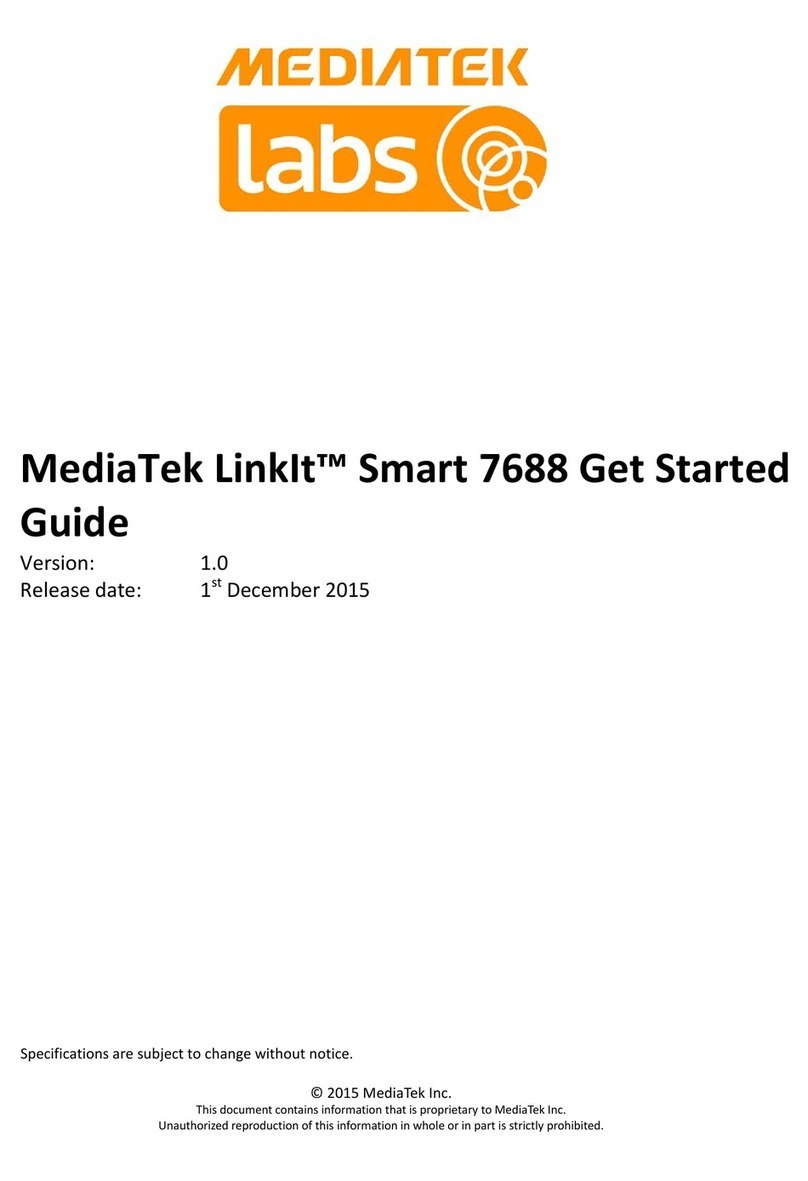
MEDIATEK
MEDIATEK LinkIt Smart 7688 Specification sheet
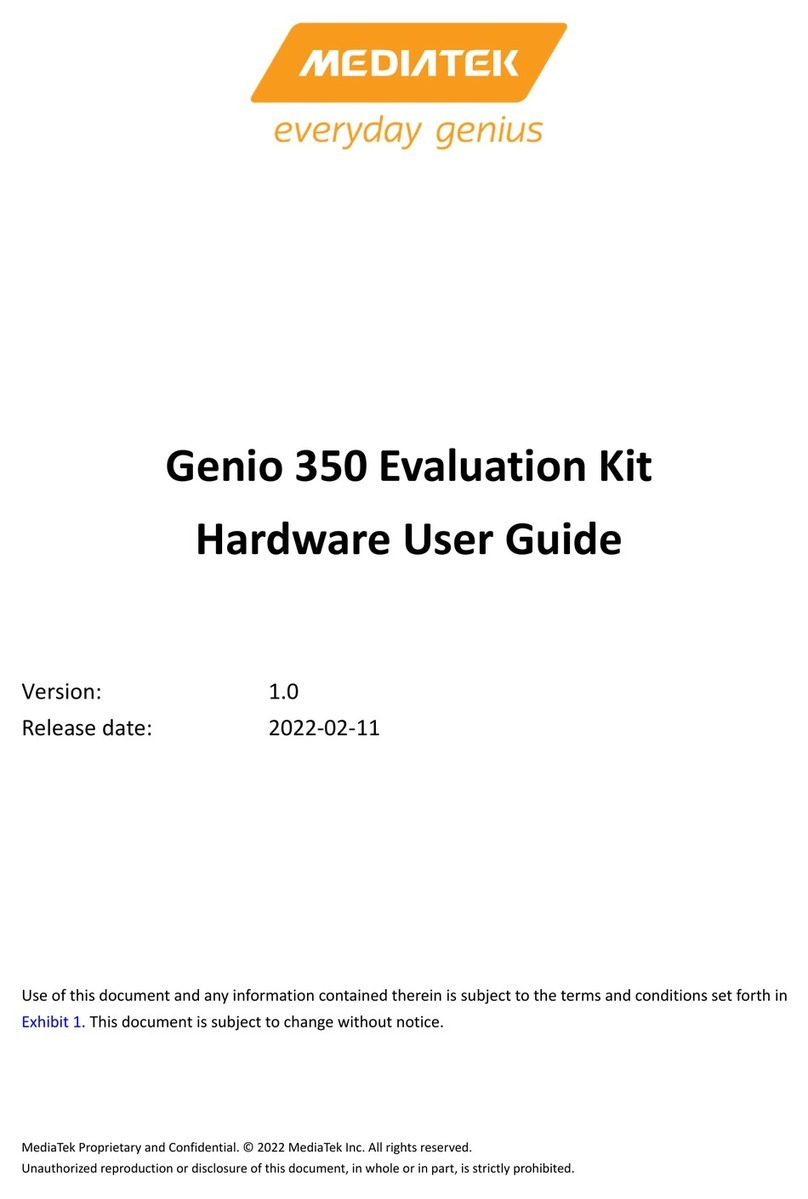
MEDIATEK
MEDIATEK Genio 350 Installation manual
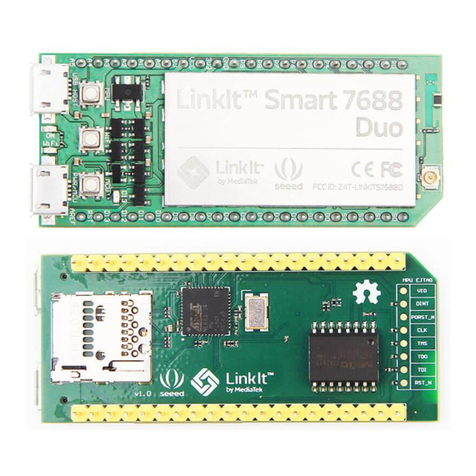
MEDIATEK
MEDIATEK LinkIt Smart 7688 Instruction Manual

MEDIATEK
MEDIATEK Genio 700 Installation manual
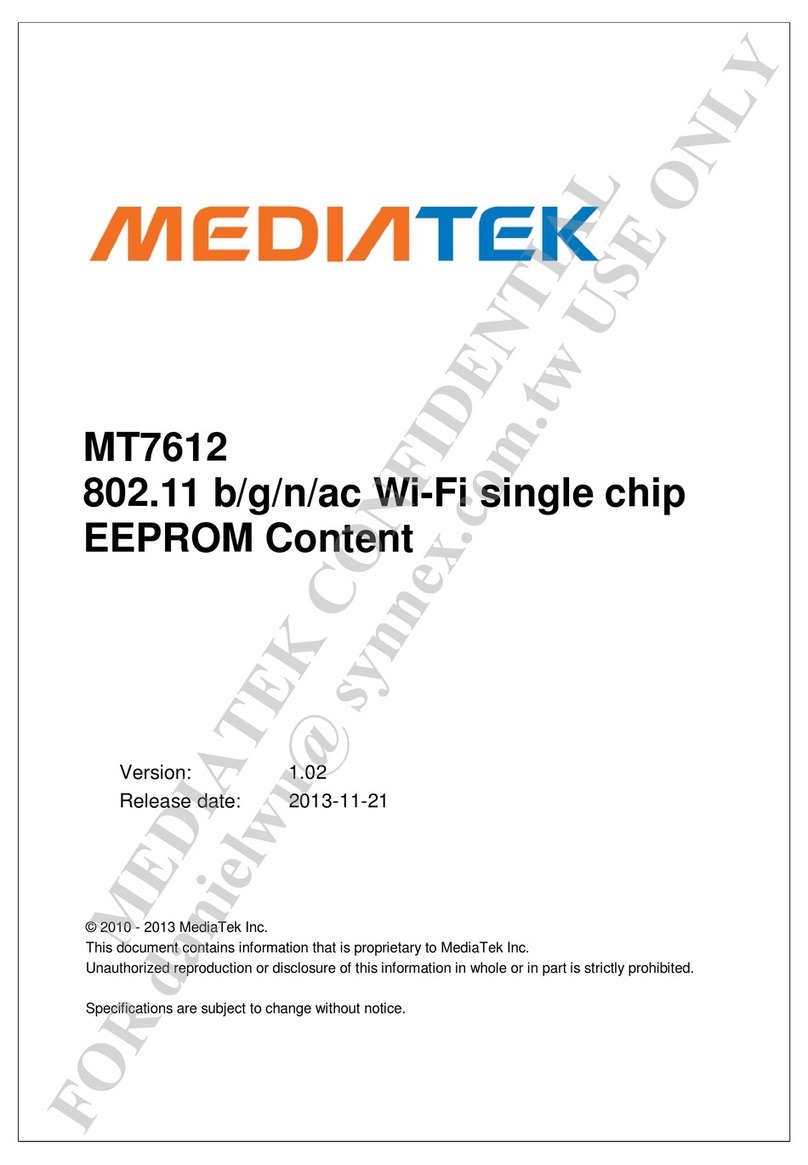
MEDIATEK
MEDIATEK MT7612 User manual
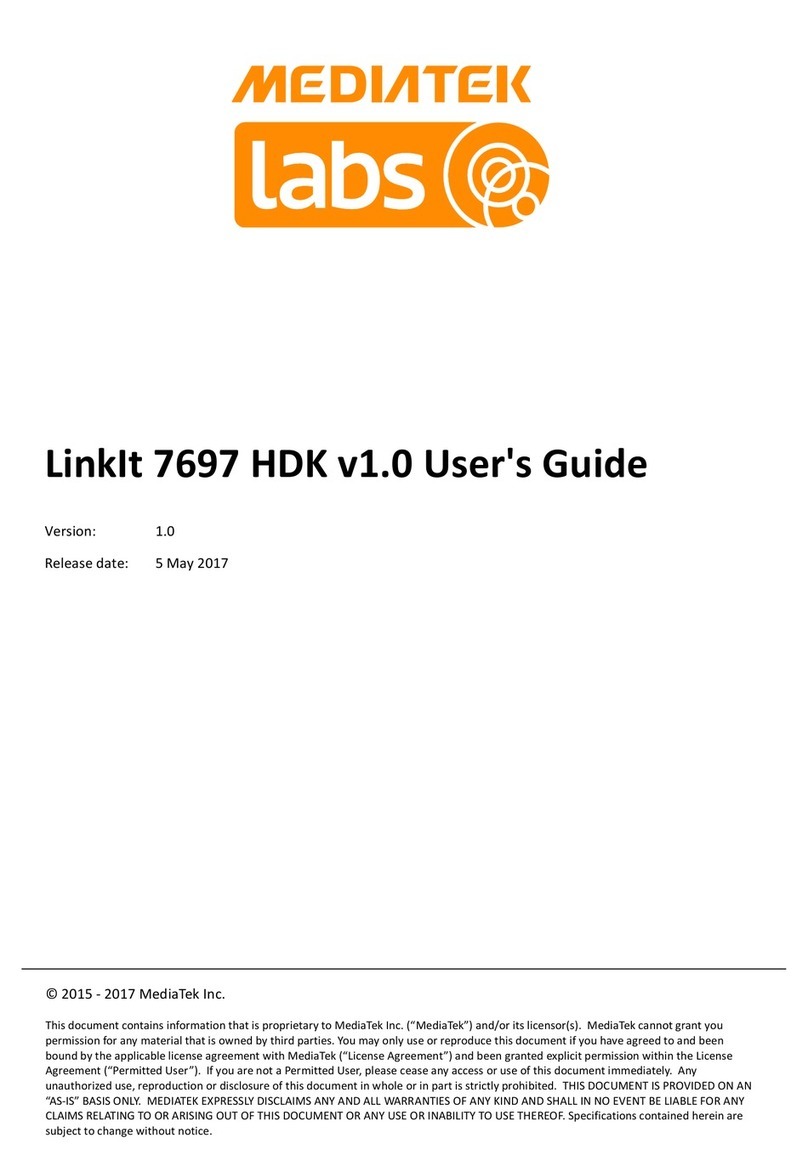
MEDIATEK
MEDIATEK LinkIt 7697 HDK User manual
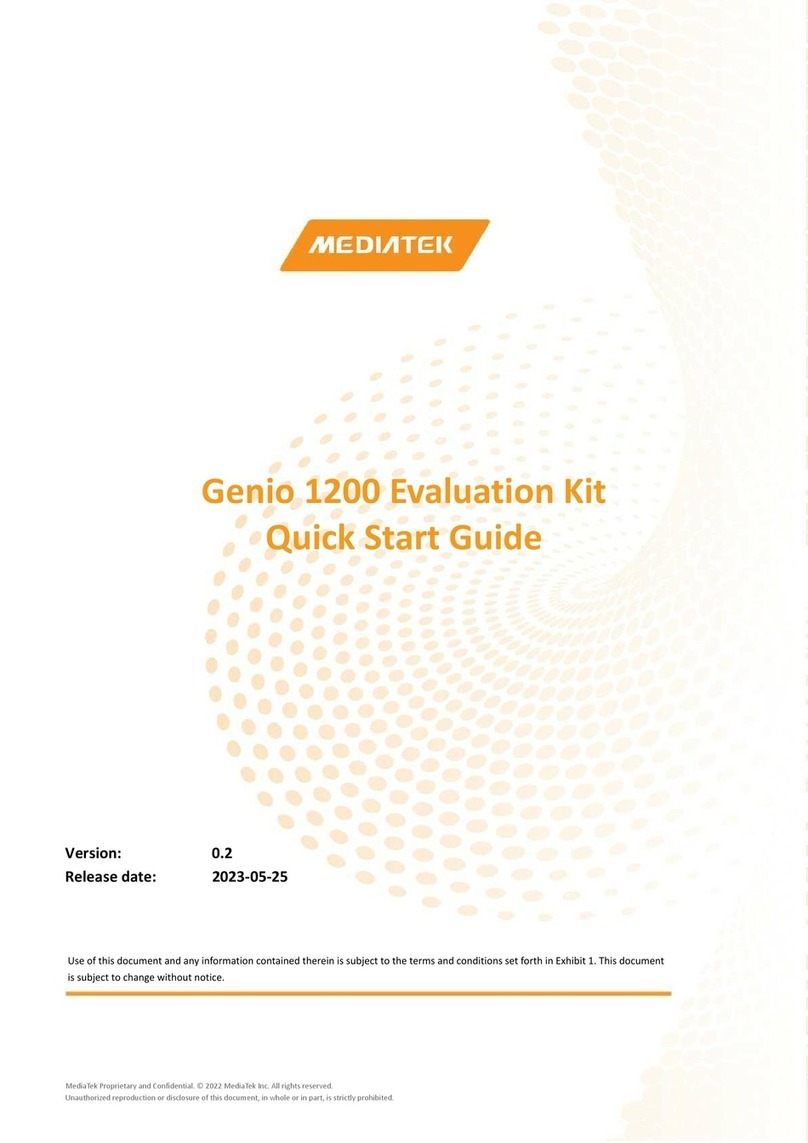
MEDIATEK
MEDIATEK Genio 1200 User manual

MEDIATEK
MEDIATEK Genio 350 User manual
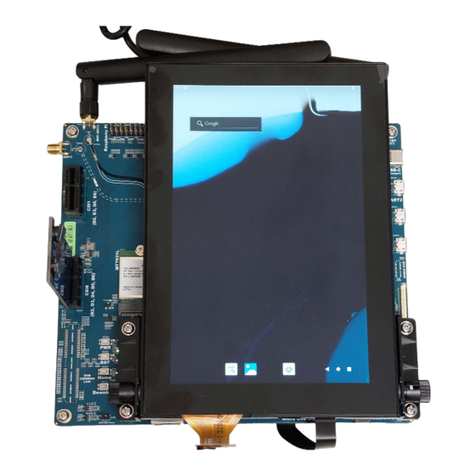
MEDIATEK
MEDIATEK Genio 700 EVK User manual

